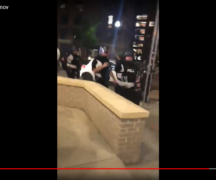The Ohio House passed two bills Wednesday that together would create new penalties and stiffen preexisting ones for people engaged in what the law considers to be “riots,” and another revoking a current police power to limit the transfer of guns and weapons during a “riot.”
House Bill 109 creates new felony offenses of “riot assault,” “riot vandalism,” and “bias motivated intimidation.” It also enhances penalties for existing offenses like rioting, aggravated rioting, disorderly conduct, and vandalism.
It also borrows language from state laws dealing with funding or supporting terrorism to expand the offense of racketeering to include knowingly providing material support to or organizing a crowd into a riot.
Lastly, it creates a new avenue for police officers to file civil lawsuits if they’re injured during a riot, if their civil rights are infringed while on duty, or if a “false complaint” is filed against the officer.
The legislation passed nearly along party lines, though Rep. Jamie Callender, R-Concord, voted with Democrats in opposition. It comes less than two years after protests erupted nationally when a Minneapolis police officer was captured on camera murdering George Floyd, an unarmed Black man. A vast majority of those demonstrations were peaceful, though an estimated 6% nationallyturned chaotic and destructive.
The second bill would strike a section of current law that allows the top police officer in a jurisdiction, when suppressing a riot or when one might arise, to cordon off the area and block through-traffic. That officer can prohibit the sale, dispensing or transportation of firearms, ammo, dynamite, or other explosives.
It passed on party lines with Republicans in support and Democrats opposed.
Riots
Its sponsors, Reps. Sara Carruthers, R-Hamilton, and Cindy Abrams, R-Harrison, said the bill is focused on the small groups of “agitators” who hijack peaceful protests and turn to destruction. Rep. Haraz Ghanbari, R-Perrysburg, who co-sponsored the bill,made similar comments, at one point suggesting that some of the protesters in 2020 were “bused in and driven in from other parts of the country.”
Democrats described the bill as an affront to people expressing their rights to speak and peacefully assemble. Rep. Dave Leland, D-Columbus, emphasized that most of what the bill targets is already illegal.
Much of the opposition centers on the broad definition of the term “riot.” Ohio law defines a riot as a group of four or more people engaged in disorderly conduct with the purpose of committing a misdemeanor. When the bill passed in committee, several social justice protesters stood in protests with red “X” letters taped over their coronavirus masks.
Several Democrats noted the racial dynamics of the issue — a mostly white group of lawmakers passed legislation to crack down on protests that formed in response to racial injustice.
“When we look at the details of the bill, there are inadvertent consequences for people simply wanting to speak and say, ‘Enough is enough,’” said Rep. Dontavius Jarrells, D-Columbus.
Carruthers said the bill isn’t about race or even any specific protest.
“This is not a racial issue, not even close,” she said. “This is about someone throwing a brick through a building.”
Guns
Rep. Scott Wiggam, R-Wooster, introduced the guns bill, a major priority of the Buckeye Firearms Association. He said while the governor and health department did not close down any gun stores during the COVID-19 lockdowns of early 2020, the bill ensures it remains that way in the future.
Democrats in the chamber said the bill infringes on a doctrine within the Ohio Constitution that calls for “home rule” on policing issues. Rep. Jessica Miranda offered an amendment to reshape the bill to continue to allow local police to limit firearm sales and transfers in a cordoned off area where a riot is taking place.
The amendment was voted down.
***
Also from Ohio Capital Journal:
Ohio House bill would allow students to use public school money on private schools
After what sponsors say was a year of work to “find the right approach,” a new version of a bill that would attach school funding to each student was introduced Tuesday in the Ohio House.
The Ohio House Finance Committee heard about House Bill 290, which would create an “opt-in” approach to private school scholarship funding, and allow students to take funding that would normally go to the public school districts with them as they opt for a private school option.
“The primary education option would remain the local assigned public school,” state Rep. Riordan McClain, R-Upper Sandusky, told the committee.
Under the bill, if a family chooses to go the private school route, an educational savings account would be created for the child, and the state’s share of educational funding would be deposited there “for the parents to find the right educational path for their child,” according to McClain.
The program would have an annual disbursement of $5,500 for K-8 students, and $7,500 for high school students, identical to the funding model of the EdChoice private school voucher program in the state. READ MORE
Local leaders launch Broadband Access Ohio to advocate for municipal broadband services
A coalition of local government officials are teaming up in a bid to protect their rights to establish municipal broadband services. In many parts of the state, high quality internet is still difficult to come by and private internet service providers aren’t lining up to fill the gap. For years now, local leaders have been stepping into the breach to provide connectivity to residents and businesses. Their new group, dubbed Broadband Access Ohio, wants to ensure they have a free hand to continue doing so.
The group’s chairman is Bill Roth, mayor of Fairlawn, Ohio, population 7,710. Thanks to their municipal broadband utility FairlawnGig, his residents can get gigabit internet access for $75 a month. For context, WOW and AT&T charge $80 for the same speed in metro Columbus.
Roth has been the city’s mayor for almost three decades, which means he’s been behind the desk since the days of dial up and he’s watched as high-speed, reliable internet became a prerequisite for business development. Roth recalled visiting an international trade show and having a positive initial meeting with a company out of Dusseldorf, Germany.
“We’re all excited we’re gonna get this company to come to Ohio,” Roth described. “Came in the next day and the individual I spoke with was one of the CEOs of the company. He said Ohio’s great, except for one thing — he said your internet is terrible. (But) he used a different word. We lost that.” READ MORE





